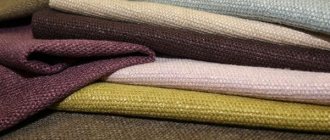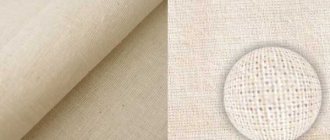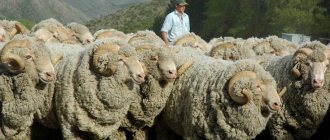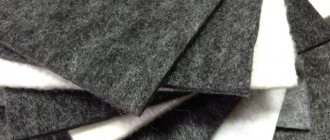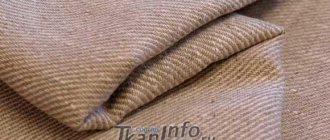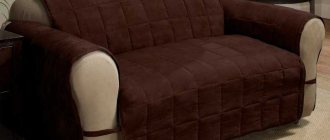Tent fabric - production features
Today, its structure is similar to tarpaulin, but it is much lighter and softer. Despite this, it perfectly protects against moisture.
Where is this type of fabric produced?
In the production of fabric, exclusively strong and thick coarse threads are used. They curl tightly together and are clearly visible in the texture. The more tightly the weft threads are twisted, the denser the structure of the fabric, but at the same time the better it protects from water. When wet, the fibers swell and fill every crack, resulting in a moisture-proof effect. When dry, the product can allow air to pass through well, so a person will feel comfortable under it.
The most important indicator of tent fabric is its density. All characteristics depend on it. According to GOST, the best options are with a density from 210 g/m2 to 270 g/m2.
Density of matter
Arctic cover for tents UP
Arctic capes are designed for additional insulation of two-layer tents of the UP series. Designed for use in regions with extremely low temperatures. The Arctic cape consists of two layers:
waterproof oxford fabric 300
Oxford serves as protection against precipitation, has a density of 300 DEN and water-repellent impregnation with an index of 4000 mm. water column. Dense fabric will ensure a long service life, and the impregnation rate will allow it to withstand any precipitation.
insulation (geofelt)
Geofelt is a synthetic fabric that combines an optimal ratio of weight per square meter and the ability to retain air in the structure of the material.
The Arctic cape duplicates the main tent, and its installation time will take no more than a minute!
How to choose tent fabric
Before purchasing, you need to visually inspect the canvas and pay attention to the following nuances:
- Front side. It should be free of shine (this indicates the presence of synthetic threads in the composition) and lint (a large number of them indicates that the cotton fibers in the composition are of poor quality). The thread twisted into a rope is clearly visible. If thickenings are visible in places, this is normal.
Fabric product
- The wrong side. Slightly shiny. This is due to the presence of water-repellent impregnation.
- If you look at the light, you can see gaps on the product. If there are many of them, then the density of the product is low, and if there are few, then, accordingly, the density is high.
- Another way to check the tightness is to fold the fabric. The thicker and tighter the fold, the greater the density.
- The more the fibers are twisted, the better the fabric will protect against water.
- Strongly twisted weft threads make the product look like a tarpaulin, but this only improves its properties.
- Impregnation. For tents it is better to choose a water-repellent one, but for awnings, awnings and covers, one that will protect against rotting.
Special clothing
Fabric for raincoat tents. Tent fabric: tourists choose only the best
A raincoat tent is a wearable camping tent item for one person, made of waterproof fabric that can serve as a raincoat and a tent. Below are the options for raincoats from different countries
The raincoat-tent in the Armed Forces of the USSR (also in the ATS countries) and Russia is a tarpaulin panel measuring 180 x 180 centimeters; leather eyelets are sewn into the corners, intended for stretching the raincoat-tent on stakes or on rope stretchers (in the forest, under trees). There are wooden buttons (“pins”) on two sides of the canvas cloth, and sewn loops on the other two sides. Thus, several raincoats can be connected into one large cloth.
The raincoat is held on the soldier's shoulders by a tied braid, movably sewn into the upper corner. Also, a second movable braid is sewn into the upper corner of the raincoat, designed to form a hood and secure it around the face. To prevent the lower corner of the raincoat from dragging along the ground and creating interference when walking, it is fastened with a grommet to a wooden “peg” located almost in the center of the canvas.
To release one hand, there is one slot in the cloth of the raincoat, fastened from the inside to a wooden “stump”. The other hand extends out between the floors of the raincoat. The raincoat worn over the shoulders can also be fastened.
Below are several photos of the construction of a raincoat tent
The raincoat set includes:
- cloth (the raincoat itself)
- two half posts
- stitching cords
- four wooden or metal pegs
As a rule, pins, half-stands and stitching cords are instantly lost or outright thrown away (they may not be given out)... not even everyone knows what is included in the kit and how to use it. This is due to the fact that the raincoat is not currently used as a tent.
How to fold a raincoat
The raincoat tent is folded in different ways.
Tie the half-posts of the raincoat tent into a bundle with a lacing rope. Some leave 30 cm of free ends of rope on each side of the bundle for tying the bundle later.
The main differences follow. Some people prefer to fold it like an OZK, putting half-racks, etc. inside the twist. Old Soviet instructions require the cloth of the raincoat to be folded in four. The resulting rectangle is cut into three stripes, the resulting strip is doubled, tripled or quadrupled (bending its ends to the middle). Half stands, etc. fits into a backpack or duffel bag.
Other ways to use a raincoat
If necessary, the design of the raincoat allows it to be used for other purposes: for camouflage, carrying cargo (wounded, dry rations, etc.); A raincoat filled with straw or hay allows you to overcome water obstacles. When placed on the ground, tents can be built from several panels of raincoat tents, and panels of raincoat tents can also be used to construct awnings, canopies, cover huts, open trenches, and cover the entrances to dugouts and huts. The raincoat can be used as a bedding when cleaning weapons in the field; a bedding when firing from a machine gun in bad weather conditions, so as not to get your uniform dirty; as an improvised tablecloth when eating in the field. A raincoat tent is indispensable when removing swept away dry leaves and other debris. Cloak tents are used to cover bunks in soldiers' camp tents. They also replace doors in war-damaged houses. They cover windows in occupied, broken down houses (and instead of glass they provide blackout, and they will also stop a grenade thrown at the window).
Popular tent fabrics and care for products made from them
There are many types of tent fabrics. They are natural and synthetic. Depending on the composition, each fabric requires certain care, ignoring the rules of which can lead to damage to the fabric.
- Pros and cons of matting: what is it, what is sewn from this material and what else is this fabric used for?
When deciding to purchase a tent, it is recommended to first study the characteristics of the most popular materials from which they are made. It is also important to learn how to properly care for them.
From natural raw materials
Tent fabric is rarely 100% made from natural materials. These materials are the safest for people, do not provoke dangerous diseases, and create a favorable microclimate inside the structure. However, they have low moisture resistance. This disadvantage cannot be offset by the advantages of natural materials. In this category of tent materials, tarpaulin can be distinguished. It can also conditionally include cotton coated with Teflon. A description of these materials is presented in the table:
Canvas fabric
| Type of natural fabric | pros | Minuses | Features of care |
| Tarpaulin | Free air circulation, accessibility, strength, density, wear resistance, environmental friendliness, resistance to high temperatures, fire, pathogens and ruptures, durability, wind resistance. | Heavy weight, low resistance to the negative effects of moisture and sub-zero temperatures, rigidity, thickness. | Dried dirt is removed with a damp cloth. More serious stains can be removed with laundry soap. Store only dry. |
| Cotton with Teflon coating | Moisture and heat resistance, color fastness, wrinkle resistance. | Difficult to maintain, limited service life. | Contamination is removed with a damp cloth. Frequent washing is contraindicated. Wash in warm water (up to 40 degrees) with laundry soap or neutral detergent. No rubbing or twisting. Dry flattened in a horizontal position. |
Cotton with Teflon coating
Synthetic fabrics
The category of synthetic tent fabrics includes Oxford called “Tourist”, Greta, Monaco, Taffeta. These materials are made from polyamide or polyester raw materials. They differ from each other not only in composition, but also in operational properties. You can use a damp cloth to clean these fabrics. They can be washed in warm water with neutral detergents. The characteristics of these fabrics are presented in the table.
Oxford
| Fabric name | Advantages | Flaws |
| Oxford | Strength, resistance to negative atmospheric factors, durability, insulation. | None |
| Greta | Strength, lightness, water resistance, color and shape stability, wrinkle resistance. | |
| Monaco | High density, strength, moisture and wind resistance, waterproof, easy to paint. | |
| Taffeta | Waterproof, quick-drying, wrinkle-resistant. | Low strength and heat resistance, airtightness. |
Taffeta
Insulation methods and materials for insulation
The tent must be insulated all around - inside and out. Materials are available and do not require large expenses. Now there are winter versions of tents on the market, but if you already have one, why buy a new one if you can insulate it yourself.
Insulating the top of the tent
The tent is insulated on top to provide additional protection from precipitation and wind. The easiest way is to use plastic film. It should be tight. The tent is covered with material and secured using office clips. From below you need to press down the polyethylene with snow or pieces of ice. Film shelter makes the tent 3-4 times warmer.
The second popular material is the fabric of an old Soviet tent. It is breathable and dense. It’s better to make a cover out of it and put it on top of the dome. Tarpaulin or Oxford protects well from the wind. With such insulation, the tent will not blow out and it will not get wet. Both of these methods increase the thermal insulation properties of the shelter by 4-6 times.
Film cover makes the tent 3-4 times warmer
It is not difficult to insulate using an awning, the main thing is that it covers a single-layer tent by at least 70%. It is preferable to make a cover that simply fits onto the structure.
Internal insulation
Insulating a winter tent from the inside is essential for harsh climates. This prevents condensation from accumulating and turning into ice. You can purchase special material or make a coating to insulate your tent yourself.
The simplest method is to insulate the walls with an old blanket. This option will not be enough for a long time, but for a slight frost, together with external insulation, it is quite enough.
A budget-friendly way is to take padding polyester or batting and staple foil onto it. You need to quilt the material in this way as often as possible so that the foil fits securely to the base. The result is a fabric with heat-reflecting properties. It is fixed to the frame using office clips. The foil layer should be positioned facing the inside of the tent so that the heat from the person and the heater does not escape anywhere.
To achieve maximum insulating effect in winter, it is better to take a ready-made specialized material - Izolon. The minimum thickness is 2mm. It is plastic, durable, and does not rot, which guarantees its reusable use as winter tent insulation. The material is made of foamed polymer with a foil coating. An analogue is Penofol, which also has reflective properties. They have one drawback - the high price.
Isolon - the inner insulation of a tent
Internal insulation of the tent will allow you to retain 6-8 times more heat.
The choice of material depends on the planned time of winter fishing. If it is planned for several days, then you need to buy professional thermal insulation.
Floor insulation
Thermal insulation for the tent floor can be selected from the following materials: camping mats, insulation or thick felt. They are easy to transport in a car when rolled up. The insulation is simply laid in one or several layers. Rugs and isolon are based on foamed polymer, which holds heat well. Felt warms due to wool.
You can insulate the floor with thick felt
It is necessary to take into account that from prolonged use the snow and ice under the heat insulator will melt and a puddle will form. Therefore, the bottom layer needs to be polyethylene.


